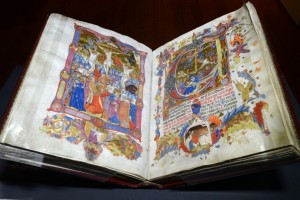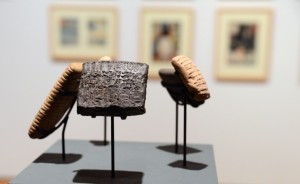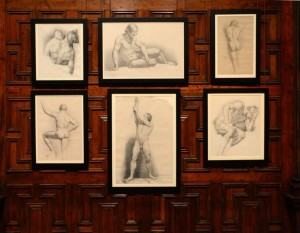 An exhibition, co-curated by Dr Cynthia Johnston of the Institute of English Studies (IES), has been receiving a lot of attention. Here, Dr Johnston explains the reasons for showcasing the unusual treasures accumulated between 1850 and the First World War by some of Lancashire’s cotton magnates.
An exhibition, co-curated by Dr Cynthia Johnston of the Institute of English Studies (IES), has been receiving a lot of attention. Here, Dr Johnston explains the reasons for showcasing the unusual treasures accumulated between 1850 and the First World War by some of Lancashire’s cotton magnates.
The Cotton to Gold exhibition at Two Temple Place brings together for the first time, collections accumulated by those who gained their wealth through the cotton boom in the north-west of England from the mid-nineteenth century.
Co-curated with Jack Hartnell of The Courtauld Institute of Art, it opened to the public on 31 January and includes immensely diverse collections: medieval manuscripts, cuneiform tablets, early printed books, Japanese prints, icons, Tiffany glass, ivories, stuffed birds and preserved beetles, 10 usually un-displayed watercolours by Turner, life drawings by Millais, book illustrations, and a 12th- century Peruvian mummy and his grave goods.
Reviews of Cotton to Gold have featured in a variety of publications – from the Guardian to Country Life, Critic’s Choice in the Financial Times (FT) to Time Out. And what has been most fascinating about them is the unexpected reactions to the exhibition. Both Jackie Wullschlager in the FT and David Gleeson in the World of Interiors queried whether these 19th-century collectors had bolder and broader tastes than collectors today.
Wessie du Toit from Apollo, while conscious of this sense of difference with regard to collectorial enterprise, read the exhibition as ‘a sense of community, bound by ethics and articulated by culture’. These engaging interpretations go well beyond our curatorial intentions, giving further pleasure to our contemplation of these collections.
Curatorial eavesdropping on visitors has been a much more perilous occupation. I overheard someone commenting on our decision to display the complete run of Roman Imperial coins in chronological order as ‘predictable’. Our intention was to emphasise the achievement of the collector, unmatched outside the British Museum. Another found the labels too high up for those with bifocals, a problem that was not anticipated and one we will remedy.
Best of all, has been the sense of bringing these little known collections into the greater public domain, and ultimately returning them to the populations for which they were intended. As someone tweeted ‘Rare to feel this full of pride to be a Blackburn lad #cottontogold @twotempleplace shows very best of my town @blackburn museum’.
Cotton to Gold is open to the public every day except Tuesdays, and entrance is free. It will continue at Two Temple Place until 19 April.
Cynthia Johnston is a course tutor for the MA/MRes in the History of the Book at the Institute of English Studies. On 18 February, 6.30pm, the Cotton to Gold exhibition will host an evening presentation of three short papers, including one presented by Dr Johnston, on the act of collecting as well as after-hours viewing of the exhibit.
